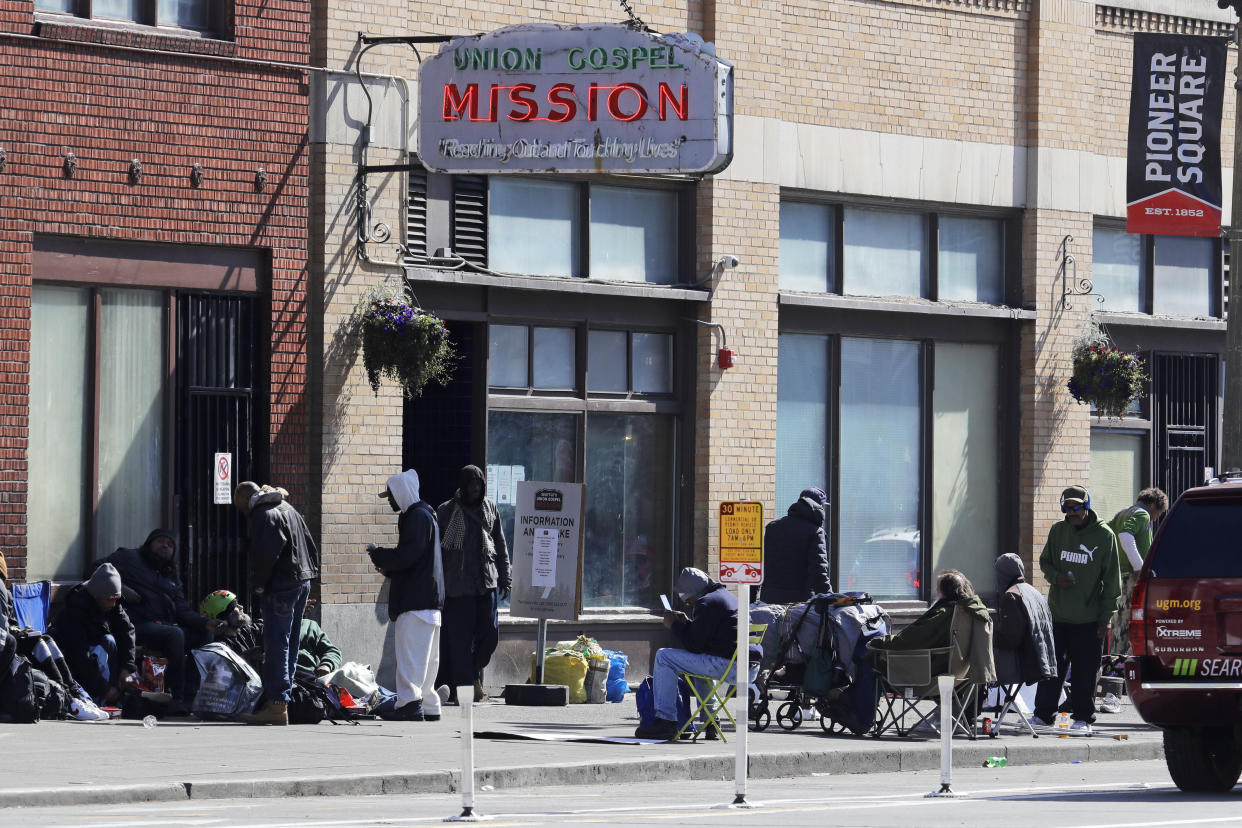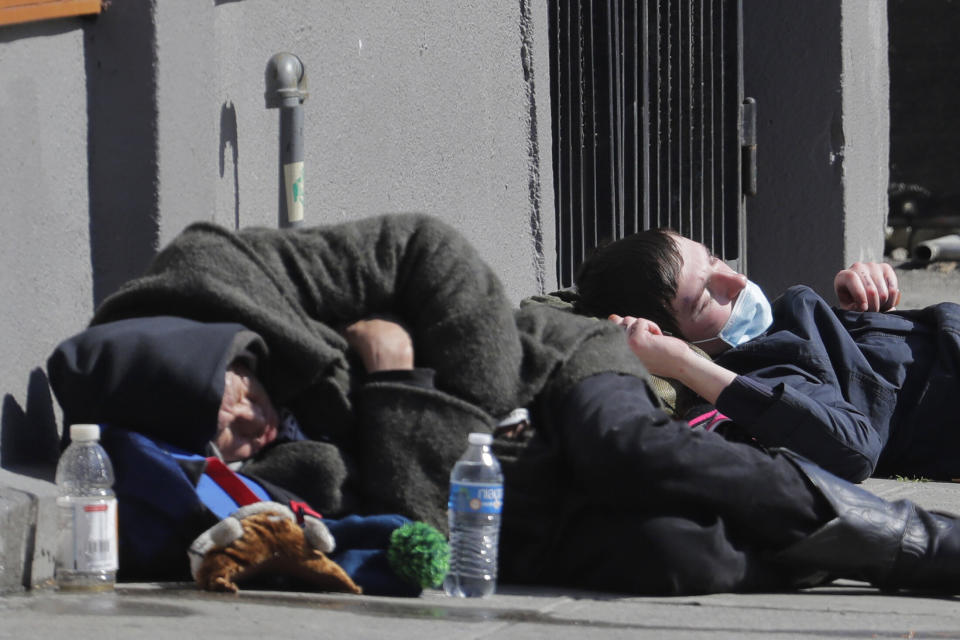Seattle's Homeless Have Few Options To Self-Isolate To Avoid Coronavirus

SEATTLE ― Thousands of elderly and immunocompromised people are experiencing homelessness in Washington state, an epicenter of the coronavirus pandemic, and the state isn’t giving them the option to self-isolate.
This puts them at serious risk for COVID-19, the illness caused by the novel coronavirus. It’s also a dangerous double standard, advocates for homeless people say. At a time when officials are urging people to self-isolate to lower the likelihood of contracting the virus or spreading it, vulnerable people who are homeless are sharing sleeping quarters and restrooms.
“The city should be giving the kind of care to the homeless population that anyone would give their parents who are in their 80s,” said Rex Hohlbein, the founder of Facing Homelessness, a nonprofit that provides direct assistance to homeless Seattle residents. “Every person living outside is in the vulnerable category.”
Finding Spaces For Shelter
The state has taken some steps to protect its homeless population. The city of Seattle and King County are moving the shelter population into new, larger spaces so that they can sleep 6 feet apart. Residents who start showing symptoms are supposed to be moved into isolation units reserved for that purpose. But until then, they aren’t able to self-isolate, even if they’re vulnerable to the virus.
People experiencing homelessness who are older than 50 tend to have more underlying health problems than the general population, according to the National Coalition for the Homeless, and are at higher risk for both chronic and contagious diseases.
One solution would be to offer more motel vouchers to people at high risk of infection. So far, King County has funded about 60 motel vouchers for older and high-risk shelter residents, according to Sherry Hamilton, spokesperson for the King County Department of Human and Community Services.
But that’s not nearly enough, advocates say. The latest one-night count of King County’s homeless population identified more than 5,200 people in shelters.
The city and county need to think long-term, said Tiffani McCoy, the lead organizer for the Seattle homeless advocacy group Real Change and a contributor to its newspaper.
“It would be better to get folks inside, where they could self-isolate, have access to hygiene services and follow public health guidelines in a way that maintains their dignity,” McCoy said.
Why People Stay Outside
Other people experiencing homelessness are sleeping outside, where they face other challenges as many public facilities have shut down, leaving them with no access to bathrooms or indoor spaces.
Seattle Mayor Jenny Durkan announced this week that the city would deploy four hygiene trailers, along with handwashing stations and portable toilets, across the city. But with most other public restrooms shut down and just six 24-hour restrooms available citywide, it will take a lot more than a few portable toilets to meet the need.
Nicki, who didn’t give her last name, stays in a tent near a Seattle public library and often uses its facilities. Like other libraries, it has been closed since March 13.
“This is one of my favorite libraries,” she said. “Most of the staff here understand that it’s hard to be out here.”

There’s a small silver lining: Now that there are fewer people downtown in general, the unhoused people who stay in tents near the library have been allowed to stay, undisturbed, in areas they’re usually forced to leave every morning.
On March 17, Durkan’s office suspended most removals of homeless encampments due to the coronavirus outbreak, though the city can still conduct site sweeps in “extreme circumstances,” such as a “fire or safety hazard” under a bridge or a tent in a play area. The city says that police and the Navigation Team, which functions as a rapid-removal squad, removed 15 encampments in March before the suspension took effect.
Many people living on the street avoid shelters to begin with. Many shelters are split by gender, and they don’t want to leave partners behind. The shelters that take couples are in high demand. Many also worry about their belongings being stolen, or they can suffer from post-traumatic stress disorder or have other mental health conditions that make living in a group setting untenable. In Seattle, as in many West Coast cities, these people tend to live in their vehicles or in tents, a phenomenon that’s instantly visible to anyone who drives on Seattle’s major freeways or walks along the city’s waterfront.
Steve, who also asked not to use his last name, and his girlfriend were staying in a broken-down trailer in far north Seattle last week when the city’s Navigation Team showed up to tow their makeshift home away, leaving their possessions in piles on the side of the road. That night, Steve and his girlfriend slept under the tarp that had been covering their trailer. He said the Navigation Team didn’t offer him shelter or any other services, but even if they had, he wouldn’t have been interested.
“I’m not inclined at all to stay in shelters — it’s nothing but drug dealing and people who’ll steal your stuff,” he said. Besides, “I’m with my girlfriend and I’m not going to split up from her.”
Another factor on Steve’s mind: avoiding contact with infected people. Ironically, people who live in vehicles and in parks may be safer from exposure than people sleeping in crowded shelters, even those that have been “de-intensified” under the new anti-crowding policies.
“Because of our living situation, we’re probably a little bit less susceptible than a lot of the general public,” Steve said.
Advocates and city officials who oppose encampment removals say they hope the county and city won’t lose interest in solving the homelessness crisis once the current public health emergency abates.
“It is interesting to me that suddenly we have all kinds of creative ideas for how we can create more shelter space for people,” said City Council member Tammy Morales, who won office last year on a campaign to “stop the sweeps.”
McCoy, the Real Change advocate, agreed.
“I’m encouraged that the county seems to be purchasing all these new buildings so rapidly,” she said, “but I wish it had happened during the homelessness emergency, because then we wouldn’t be scrambling to house the homeless population now.”
A HuffPost Guide to Coronavirus
Read our live blog for the latest updates from HuffPost reporters around the world
Living in a lockdown? Our reporters in Europe have advice on how to cope.
Why you should act like you already have coronavirus, even if you don’t have symptoms
Doctors answer the most common coronavirus questions
What to do if your friends or family aren’t taking coronavirus seriously
Please don’t believe these coronavirus scams
10 ways to practice solidarity while social distancing
What coronavirus questions are on your mind right now? We want to help you find answers.
Love HuffPost? Become a founding member of HuffPost Plus today.
This article originally appeared on HuffPost.

